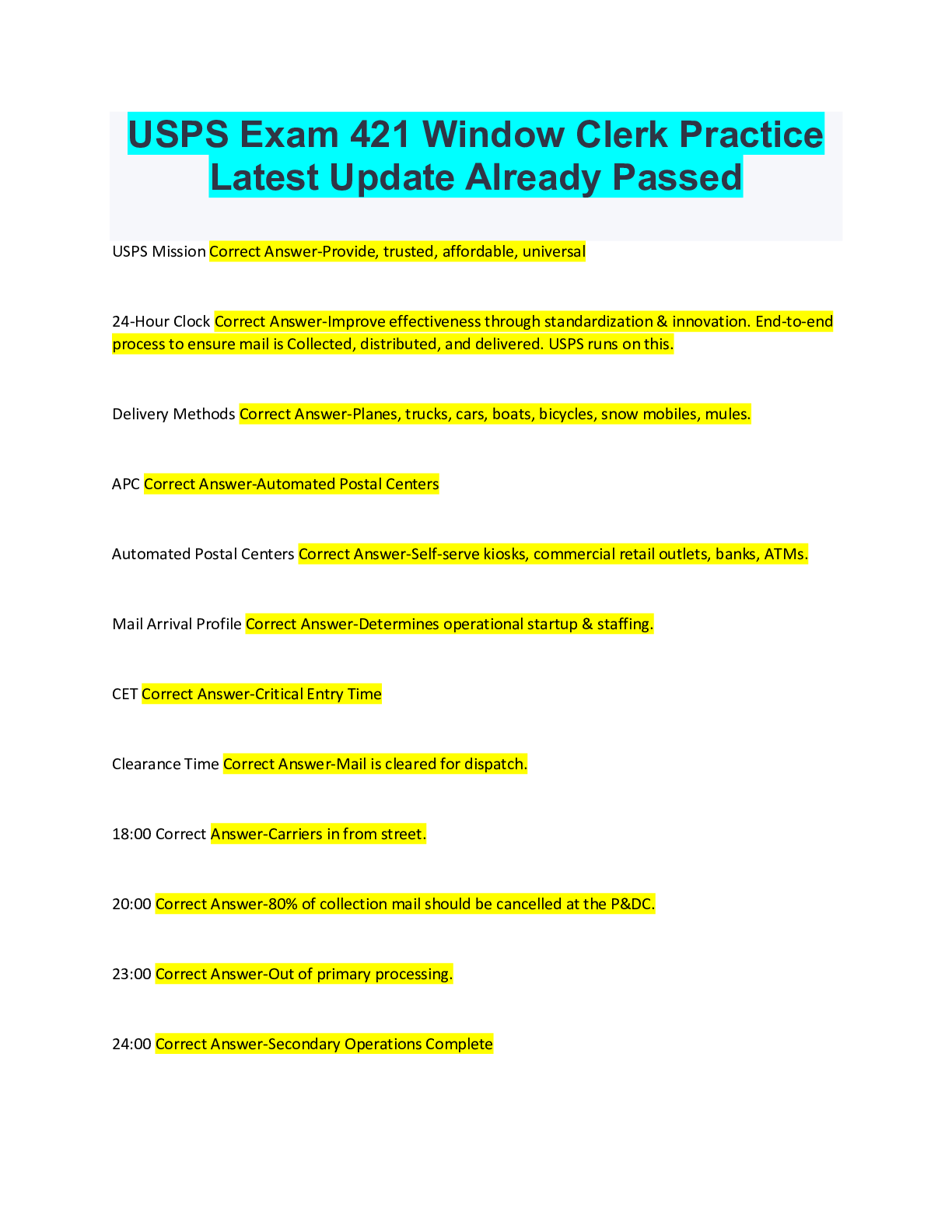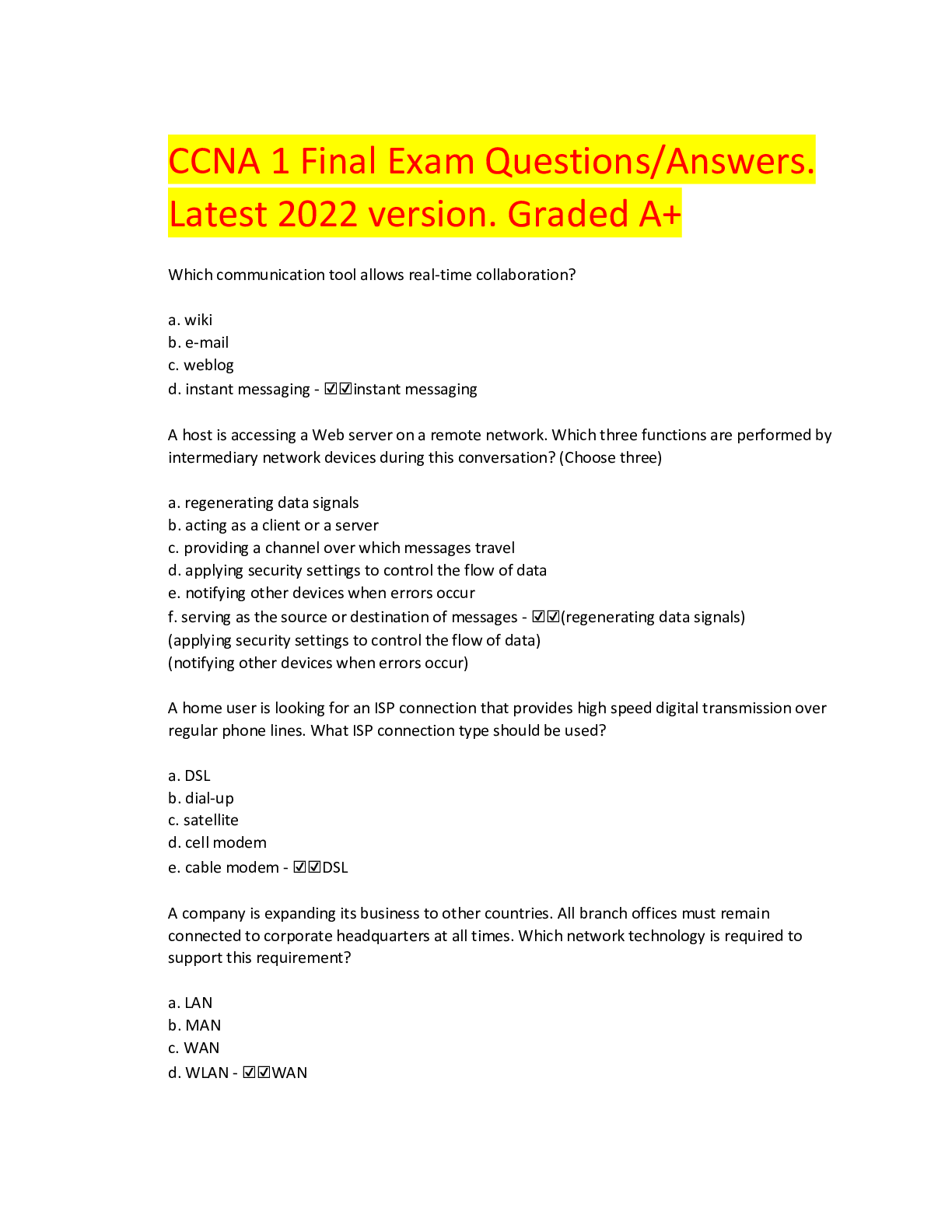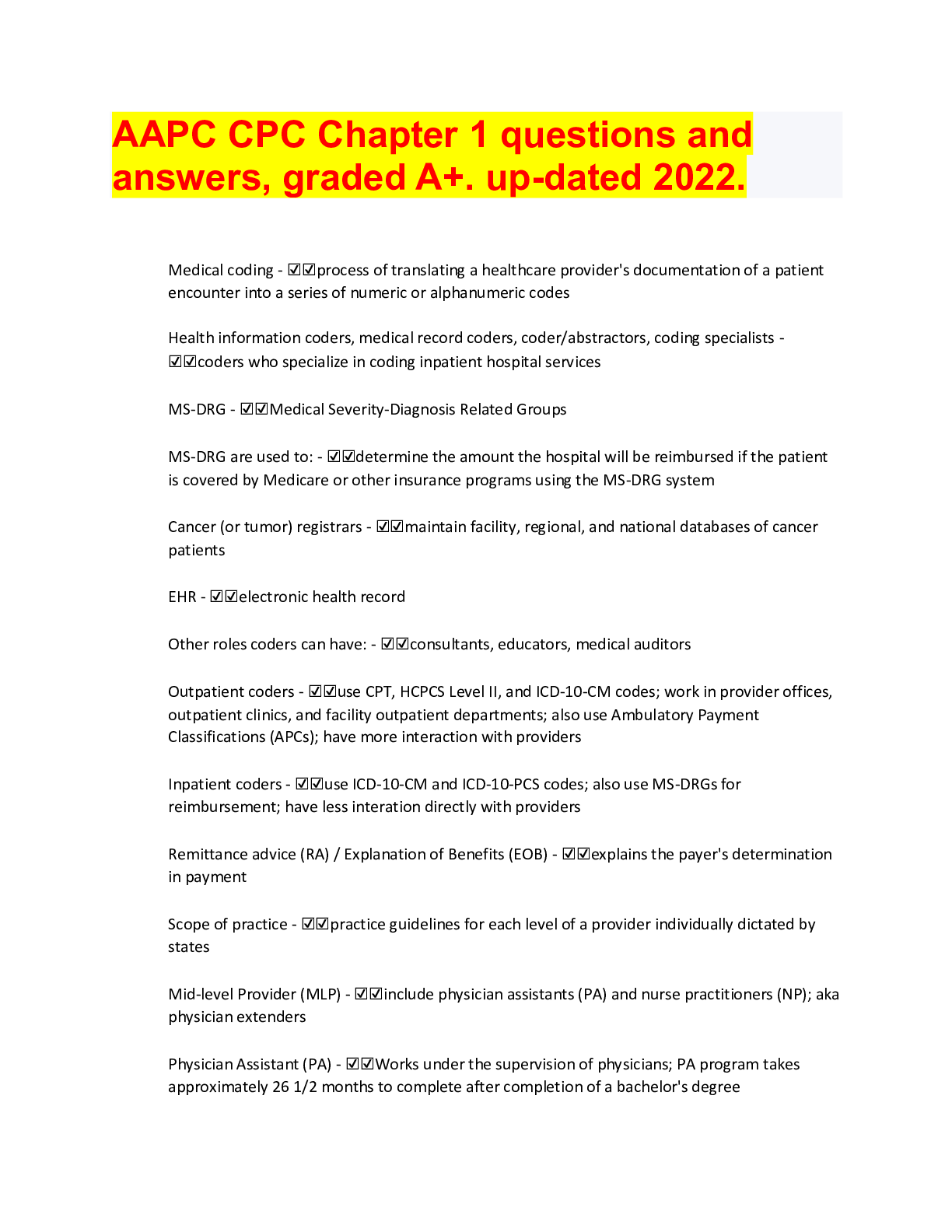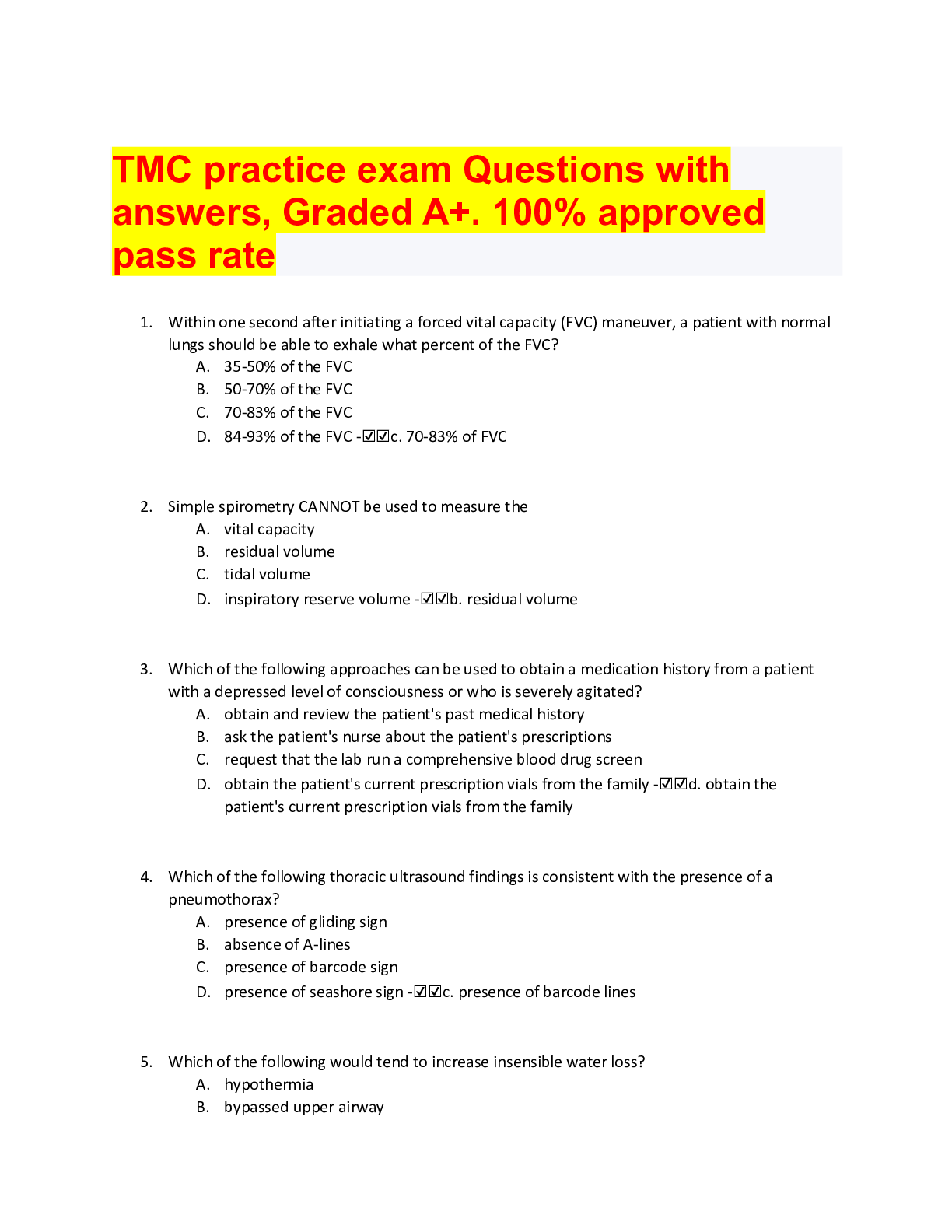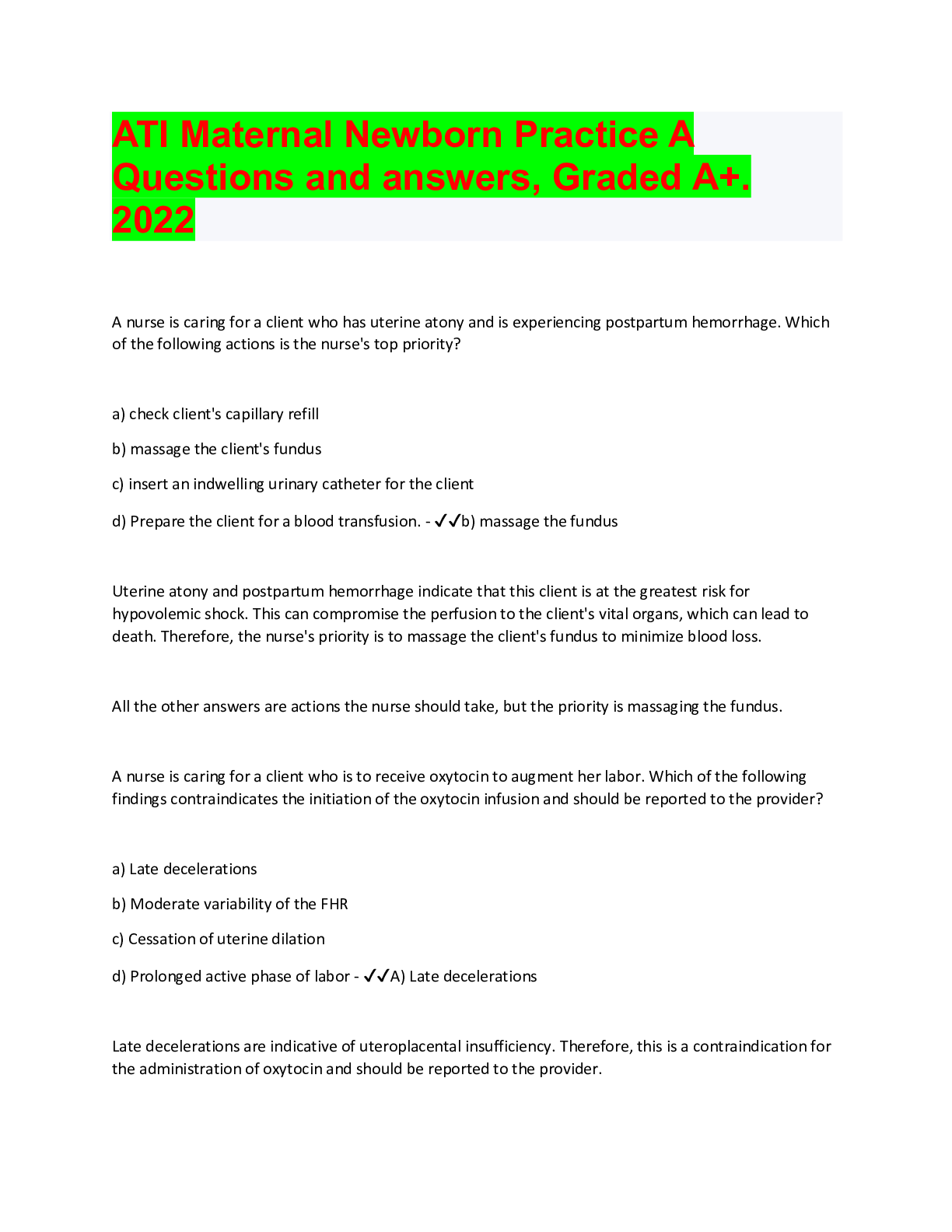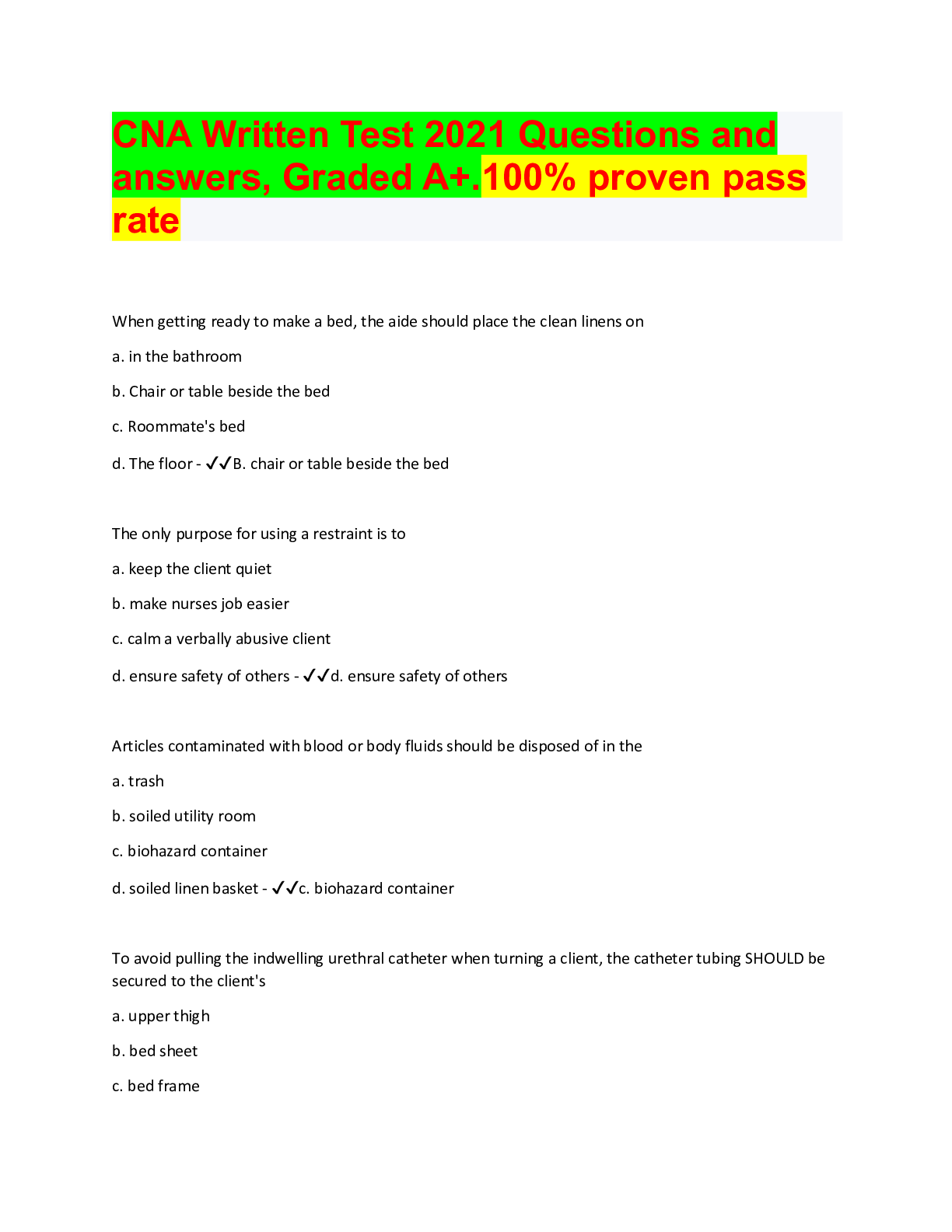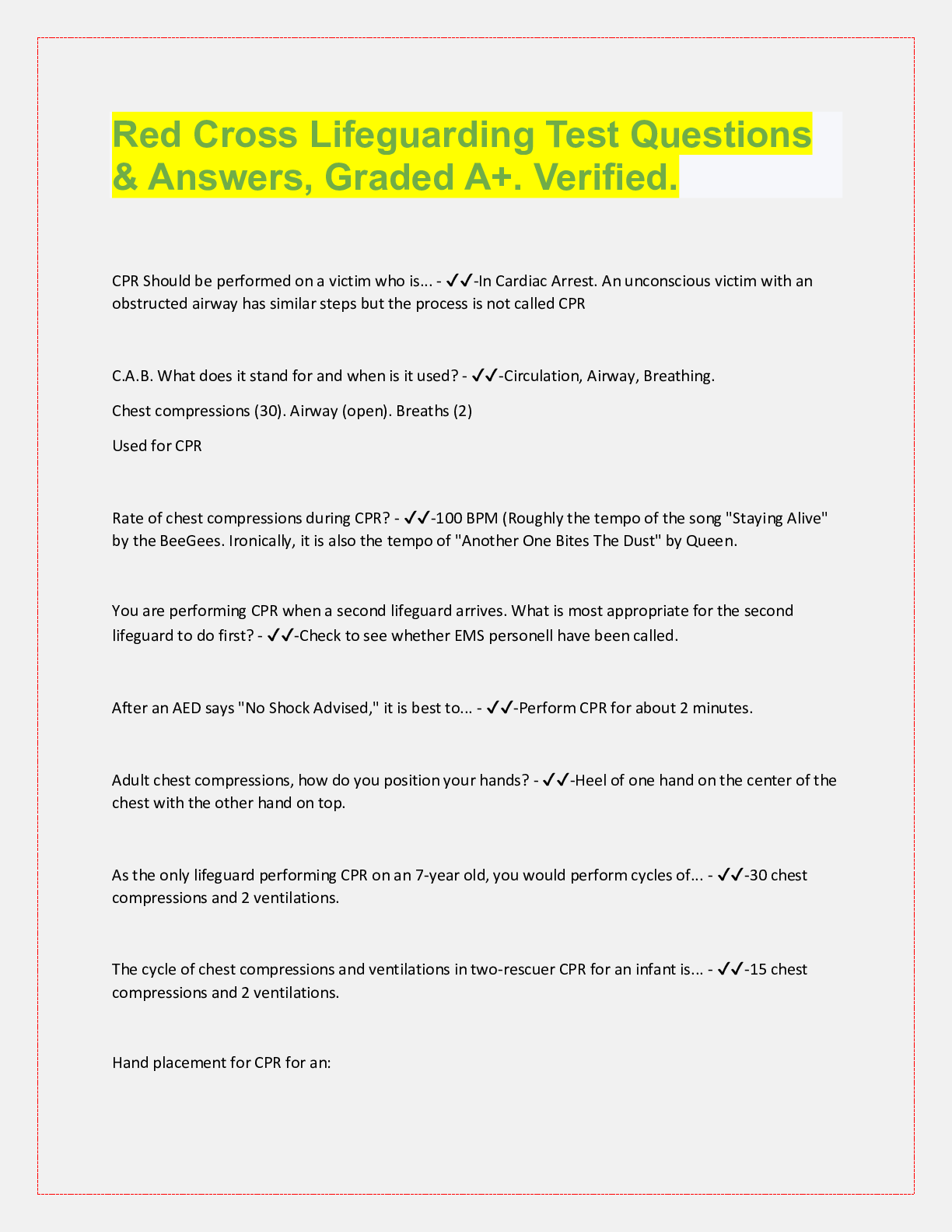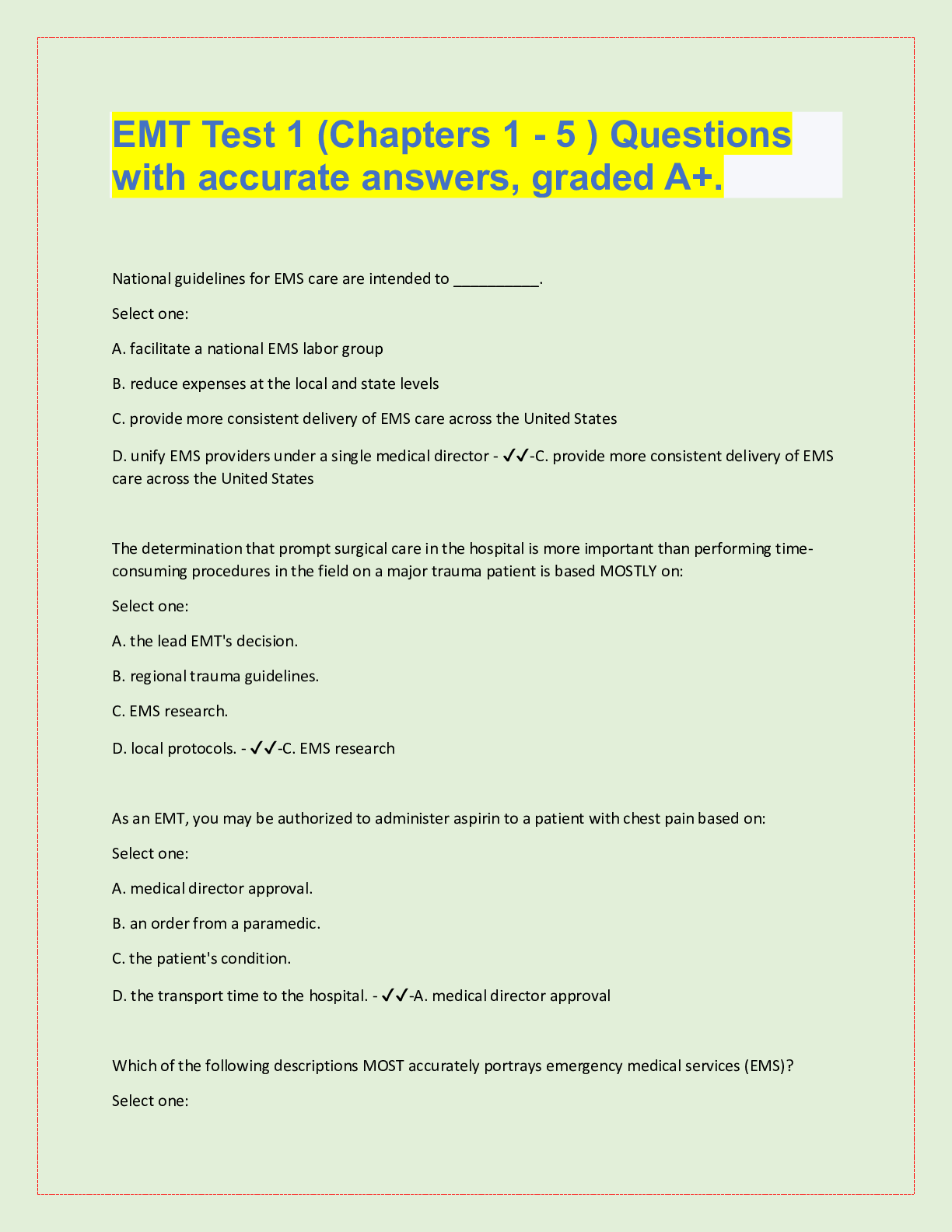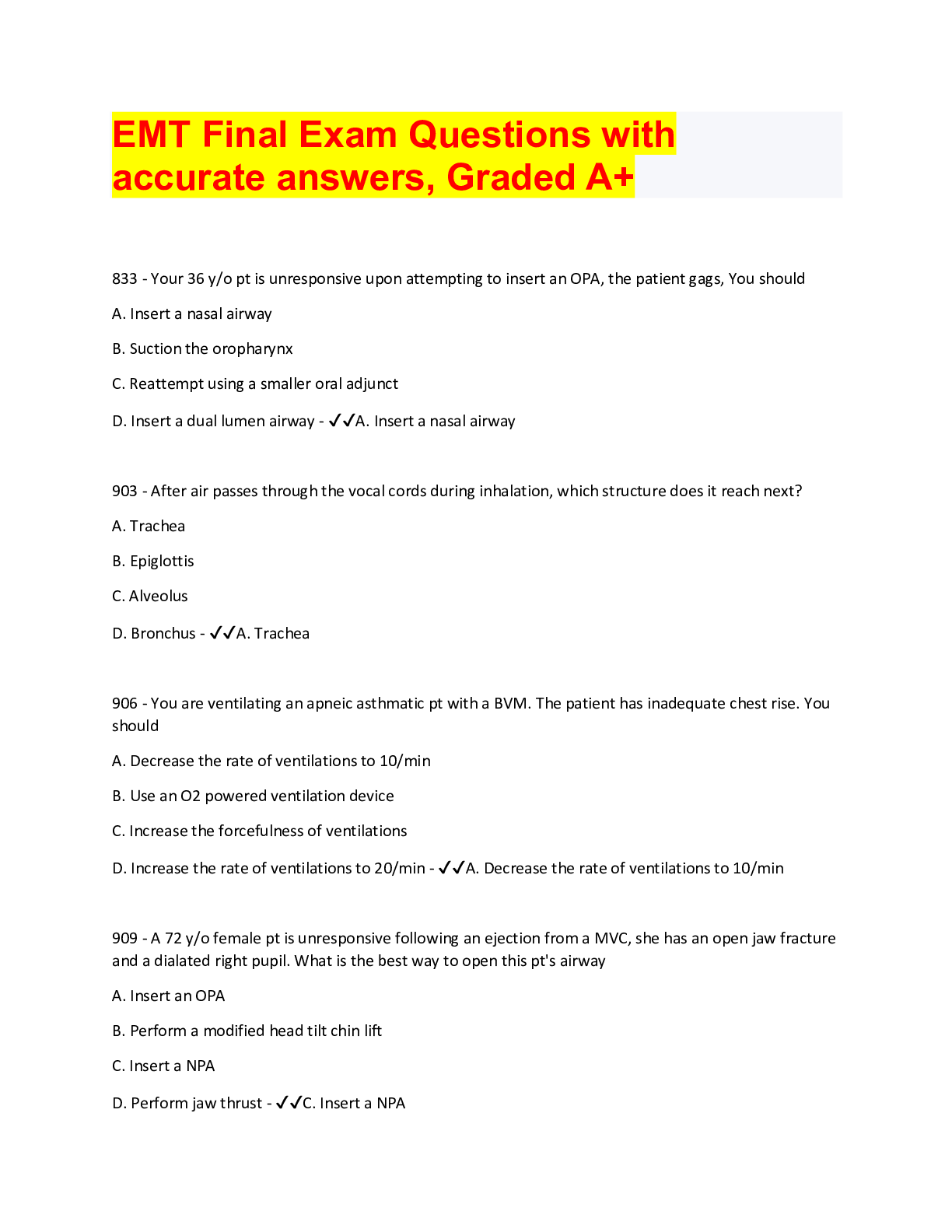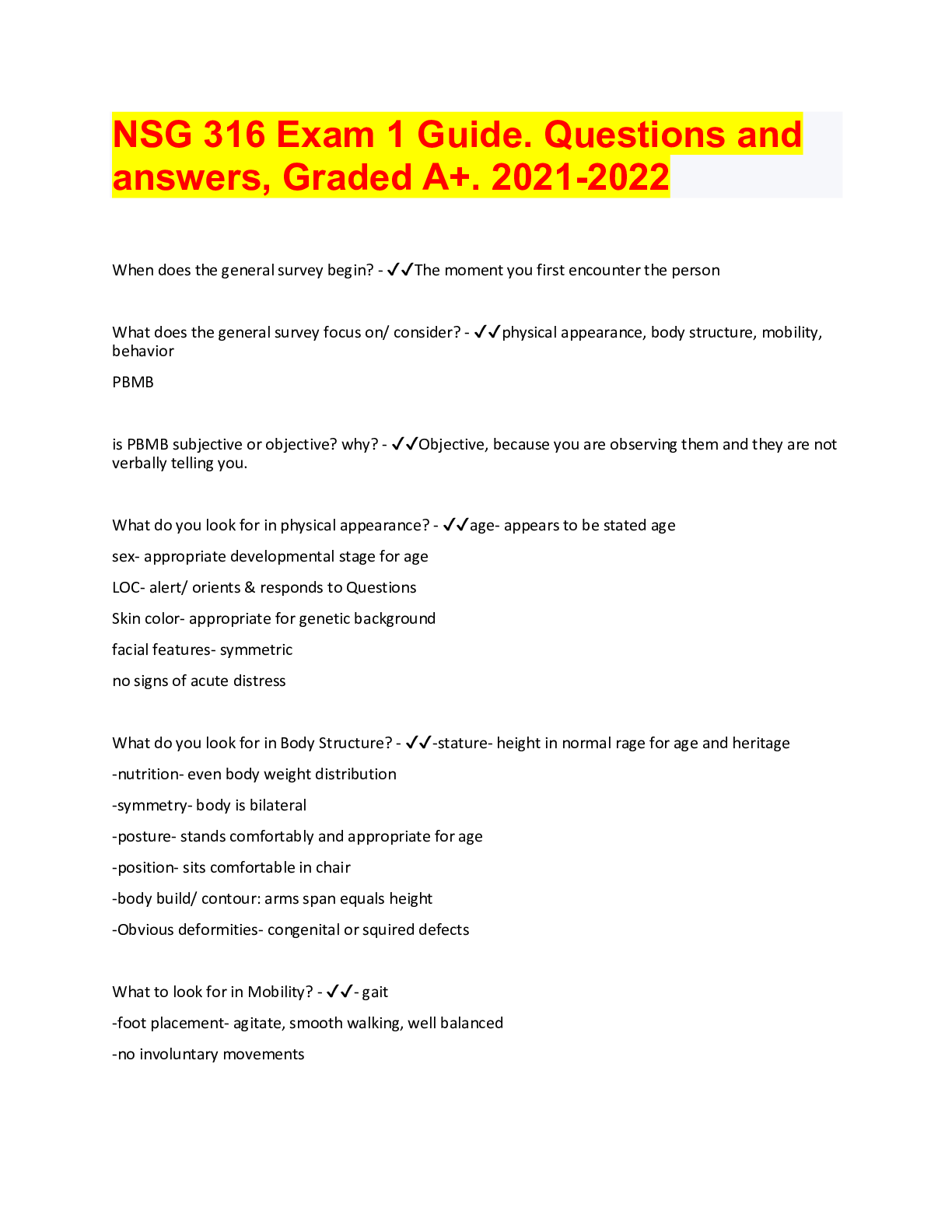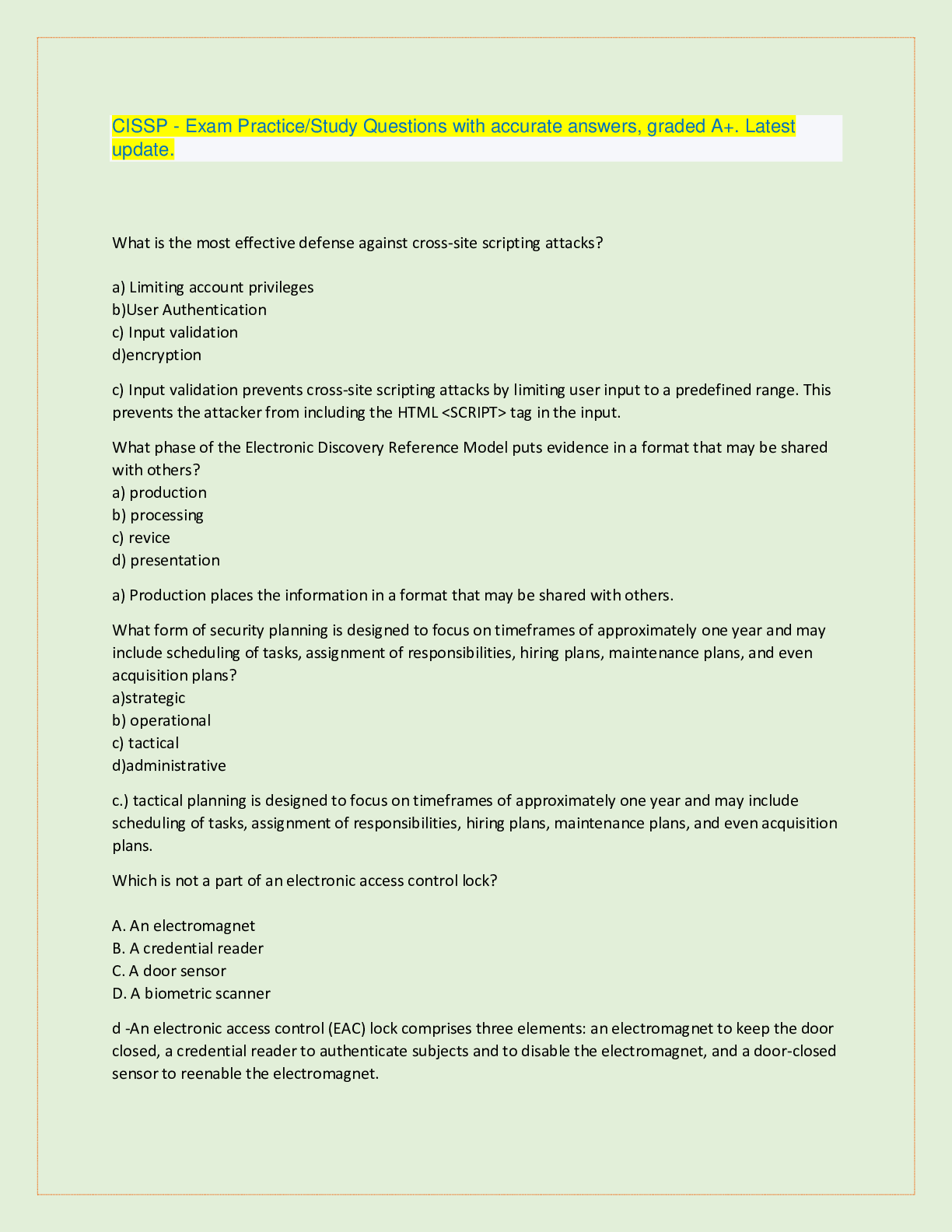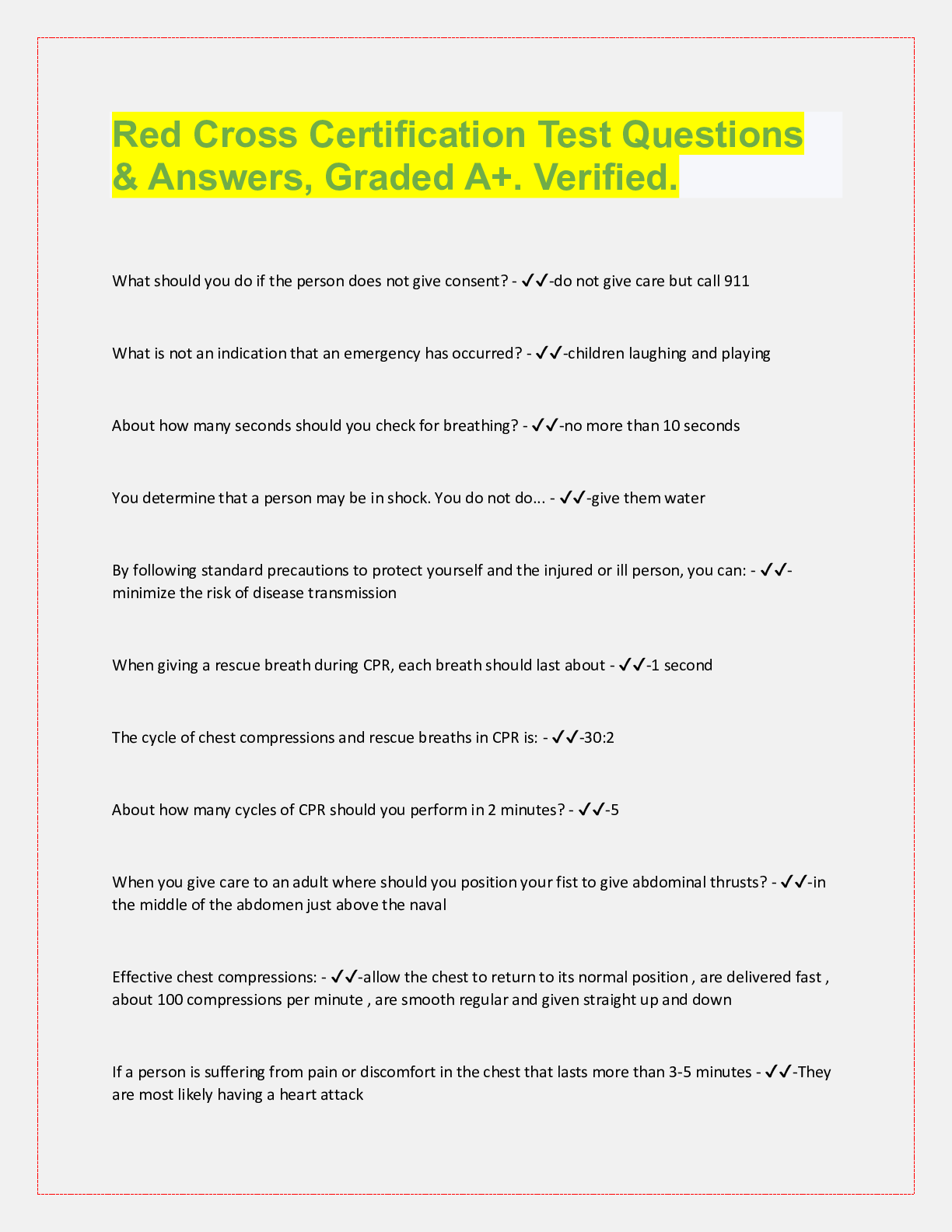*NURSING > QUESTIONS & ANSWERS > CNL Questions 101-150. 100% accurate answers, graded A+. Latest 2022 version (All)
CNL Questions 101-150. 100% accurate answers, graded A+. Latest 2022 version
Document Content and Description Below
*Tara, a CNL on a pediatric medical-surgical unit, conducted a 5P assessment and discovered that the discharge process was fragmented and parents were not satisfied with the process. Tara created a te... am to develop a change in order to improve the process. What model can Tara use to rapidly implement this change and test it to determine effectiveness?* A. Plan-Do-Study-Act (PDSA) B. Strengths, weaknesses, opportunities, and threats (SWOT) analysis C. Fishbone diagram D. Gap analysis - ☑☑Answer A—Rationale: PDSA is a model used to conduct rapid cyclical review of a process change to encourage continuous and ongoing efforts to improve. *A Native American patient is admitted with sepsis from a urinary tract infection. The patient is very weak and unable to ambulate much further than her room. The patient tells the CNL that she is very discouraged and feels that she is not able to get better because she is unable to touch "mother earth" with her feet. The CNL gathers some dirt, grass, and flowers from outside the hospital and places it in a bucket. The CNL brings the bucket in the patient's room and helps her to stand on the dirt. Which of the following best describes what the CNL is demonstrating?* A. Cultural knowledge B. Cultural awareness C. Cultural skills D. Cultural management - ☑☑Answer C—Rationale: Cultural skills are described as the ability to identify, assess, and incorporate the values, beliefs, and cultural customs of an individual. *A nurse comes to you with a concern about a telephone order she received from a doctor. The doctor asked her to review a physician order for life-sustaining treatment (POLST) form with a client, then sign and place it in his chart. The nurse is uncertain if this is in her scope of practice. You advise the nurse to:* A. Complete the form as ordered by the MD B. Review the hospital's policy and procedure manual, and handle per policy C. Review the State Board of Nursing Scope of Practice and handle according to your scope of practice D. All of the above - ☑☑Answer C—Rationale: The CNL should identify the State Board of Nursing as the correct source of any scope of practice questions, and advise the nurse that it is not within her scope. *How can a CNL help to identify the general discharge needs of patients on his or her unit?* A. Coordinate outpatient care and follow-up appointments B. Assess protective and predictive factors of patient health C. Discuss with each team's doctors the anticipated discharge needs of their patients D. Approach staff nurses about their patients' discharge needs. - ☑☑Answer B—Rationale: Assessing protective and predictive factors of patient health is the best way a CNL can identify potential needs or issues with patient discharges *Lisa, a CNL, is educating the staff on the effects of long-term bed rest. A majority of these patients have been on bed rest with a shortened cervix since 25 weeks gestation. Which of the following statements is true?* A. Bed rest is psychologically healthy. B. Music therapy can ease the psychological effects of bed rest. C. Bed rest prevents deep vein thrombosis (DVT). D. Bed rest has been proven to prevent preterm labor. - ☑☑Answer B—Rationale: Bed rest can be detrimental to a mother's psychological well-being, because there is separation between the patient and her family. The patient can also experience financial burdens, which put a strain on the family. Currently, there is no evidence that bed rest prevents preterm labor. *Recently, several major practice changes have been implemented hospital-wide at your facility. While all of these changes are evidence based, some of the practice changes have been received by the staff on your unit with strong resistance and poor compliance. As the CNL, you recognize that the best way to approach this issue is to:* A. Have the unit manager write-up noncompliant staff B. Advocate to have the policies altered or revoked C. Form a task force of involved parties to identify barriers to compliance D. Re-educate staff on the policies and their importance - ☑☑Answer C—Rationale: While any of these interventions may be appropriate, when addressing any issue, especially issues with strong opinions and various stakeholders, it is critical that the CNL solicit input from all invested players. *Ongoing risk reduction and patient safety efforts are an important component of:* A. Quality improvement (QI) B. Knowledge management C. Change theory D. Complexity theory - ☑☑Answer A—Rationale: Ongoing risk reduction and patient safety monitoring are components of QI. *You are in the process of initiating a mobility team and protocol on your unit. What members of the interdisciplinary team should be considered?* A. Nursing staff, physical therapist, nurse manager, occupational therapist, CNL, clinical nurse specialist, and physician B. Physical therapist, physician, nursing assistants, manager, and CNL C. Medical social worker, physician, nursing staff, physical therapy staff, and CNL D. Physical therapist, occupational therapist, nursing staff, and the discharge coordinator - ☑☑Answer A—Rationale: An interdisciplinary team must include all key stakeholders so that patients can have the best outcomes. *As a CNL on a very busy medical-telemetry unit, you have noticed that nurses are not utilizing incentive spirometry for patients with acute or chronic lung conditions. To ensure that patients are given the best care, you ask the electronic order entry representative to allow incentive spirometry to be entered as a nursing task. This will be used as a reminder for the nursing staff to perform this task. What action of the CNL is this?* A. Demonstrates use of health care technologies to maximize health care outcomes B. Understands your microsystem and uses available resources C. Unfreezes D. Identifies unwanted variation, rework, and waste - ☑☑Answer A—Rationale: The CNL is on the frontline at the point of care delivery, making recommendations to management and other providers about disease management and use of standardized protocols, ensuring that all charges incurred are assessed and tracked to the appropriate cost center. The CNL should be involved in health care technologies and informatics. *You are precepting a CNL student. She discusses her capstone project with you. She needs help determining the design of her study. She states that she will be working with diabetes patients on a medical unit. She intends to collect basic data and do a pre- and postintervention questionnaire based on the diabetes survival skills. She wants to compare the pre- and postdata to determine if her educational intervention was effective. She will not use randomization. What option best describes her study design?* A. Well-designed randomized controlled trial (RCT) B. Quasi-experimental C. Meta-analysis D. Quality study - ☑☑Answer B—Rationale: A quasi-experiment is not a true experiment. A quasi-experiment does not have randomly assigned groups, but would include pre- and postmeasures. *B.F. is a 52-year-old female recently placed with the palliative care team. The CNL makes sure that B.F. is transferred to another unit with a specific palliative care section. How is this a demonstration of advocacy?* A. Physicians understand when to transfer patients. B. It ensures that the system meets the needs of the population. C. It advocates for the professional nurse. D. It applies ethics toward patient care. - ☑☑Answer B—Rationale: Make sure the patient is placed where the most optimal outcomes and palliative care can be delivered. *As a CNL on your unit, you are rounding on your microsystem. Jen, a 70-year-old patient with stage IV cancer, chronic obstructive pulmonary disease (COPD), diabetes mellitus (DM), and chronic kidney disease, is currently on an Ativan drip and morphine drip. She has a do-not-resuscitate (DNR) order and is a hospice patient. You notice she has multiple grieving family members in her room. You speak with the family and collaborate with the palliative care unit (PCU) CNL and charge nurse and decide to move the patient to a bigger room in the PCU. What CNL role was demonstrated in this scenario?* A. Advocate B. Outcomes manager C. Team manager D. Risk analys - ☑☑Answer A—Rationale: The CNL acted as a client advocate to ensure the best situation for the patient and family by coordination of care through the use of resources and services. *With health care reform, the CNL recognizes that evidence-based practice (EBP) is imperative. The CNL decided that her staff should be knowledgeable about health care reform. She collaborated with the educator and administration team to educate the staff about health care reform and pay for performance. What statement best reflects the definition of pay for performance?* A. It is a voluntary program that encourages hospitals nationally to report quality measures for heart attacks, heart failure, and pneumonia. B. It is a national program in which physicians and hospitals receive more money if their quality measures exceed certain benchmarks or if the measures improve year to year. C. It is a process that involves the surveillance of and intervention in clinical activities of physicians for the purpose of controlling costs. D. It is a Medicare program that began the physician quality reporting initiative. - ☑☑Answer B—Rationale: Pay for performance gained widespread acceptance in health care; it goes one step above pay for reporting, as it requires physicians or hospitals to report quality measures, in which they receive more money if their quality measures exceed certain benchmarks or if the measures improve year to year. *A nurse on the CNL's unit asks about accessing patient education materials via the electronic health record (EHR), as well as the availability of education on Cambodia. As the CNL guides the nurse in locating these materials, she or he recognizes this as an effective use of:* A. Health care informatics B. Research utilization C. Clinical knowledge D. Evidence-based research - ☑☑Answer A—Rationale: Accessing appropriate education in patients' native language is culturally competent; however, the ability to locate and provide these materials is effective use of health care informatics. *Which of the following best demonstrates how the CNL exhibits collaboration?* A. Sets and shares clear goals for teams B. Keeps all team members informed by e-mailing updated minutes C. Includes all contributors to the health care delivery process in the team, including patients/family, and seeks consultation from all members when making decisions D. Monitors and evaluates the use of technology and information systems - ☑☑Answer C—Rationale: The CNL seeks collaboration and consultation with all contributors to the health care delivery process, including the patient and family. *The CNL works in a small primary care practice and has identified that several patients have missed appointments. After investigating why the patients were not going to appointments, the CNL determines that the patients made the appointments so far in advance that they forgot them. The CNL discusses these findings with the team and they decide to implement a program with reminder calls 2 days prior to the appointment. The CNL wants to be sure to identify aspects that may positively or negatively affect the project, so the CNL suggests the team utilize which of the following?* A. 5P (persons, patients, professionals, processes, patterns) assessment B. Plan-Do-Study-Act (PDSA) cycle C. Strengths, weaknesses, opportunities, and threats (SWOT) analysis D. 5S methodology - ☑☑Answer C—Rationale: A SWOT analysis is a vital assessment for successful planning and implementation of a change. A SWOT analysis is used to determine strengths, weaknesses, opportunities, and threats that may affect the project. *As the CNL is integrated into practice, what best defines his or her level of practice?* A. Unit system B. Mesosystem C. Microsystem D. Macrosystem - ☑☑Answer C—Rationale: The CNL works on the microsystem level. *Part of your hospital's pre-op admission process is to collect a urinalysis (UA), hemoglobin A1c (HgA1c), comprehensive metabolic panel (CMP), and complete blood count (CBC). You review the HgA1c results of these patients. As the CNL, how can you best work with your health care team to ensure health promotion of clients with elevated HgA1c results?* A. Inform patients of elevated HgA1c results, as well as implications of those results B. Provide diabetes education to patients with elevated HgA1c results postoperatively C. Place a consult for the diabetes educator to meet and evaluate patients with an elevated HgA1c during this admission D. Inform the surgeons of these elevated HgA1c results and ask them to consider what the next step should be - ☑☑Answer C—Rationale: CNLs should work to incorporate other members of the interdisciplinary team in the patient's care when needed and appropriate. *Lateral integration is one of the main functions of the CNL, incorporating multiple disciplines into the care of clients and populations. Which of the following ongoing components constitute lateral integration?* A. Advocacy, assessment, clinical knowledge, evaluation B. Collaboration, communication, coordination, evaluation C. Altruism, benchmarking, cost reduction, evaluation D. Advocacy, collaboration, coordination - ☑☑Answer B—Rationale: Communication, collaboration, coordination, and evaluation—while all the components listed make up important aspects of different CNL roles, only these four address lateral integration. *A client on your unit receives 10 times the ordered dose of an opioid, resulting in serious complications from which the patient fully recovered. In response to this occurrence, you as the CNL:* A. Reprimand the nurse who administered the medication in error to ensure it does not happen again B. Conduct a failure mode-effect analysis C. Conduct a root cause analysis (RCA) D. Apologize to the client and family - ☑☑Answer C—Rationale: The priority is to conduct an RCA, which would include investigating what occurred with the nurse who administered the opioid and identify any issues in personal or unit process that may have affected the error, to prevent not only the individual nurse from making the same mistake again, but the whole unit from making a similar mistake. Errors should be met with investigation, not with punishment. If there is a performance issue, then it should be addressed by management. *In your cohort you work with all members of the team. You develop an effective plan of care across settings in collaboration with all disciplines, professions, and stakeholders, including patients. This would be an example of what component of lateral integration?* A. Communication [Show More]
Last updated: 1 year ago
Preview 1 out of 15 pages
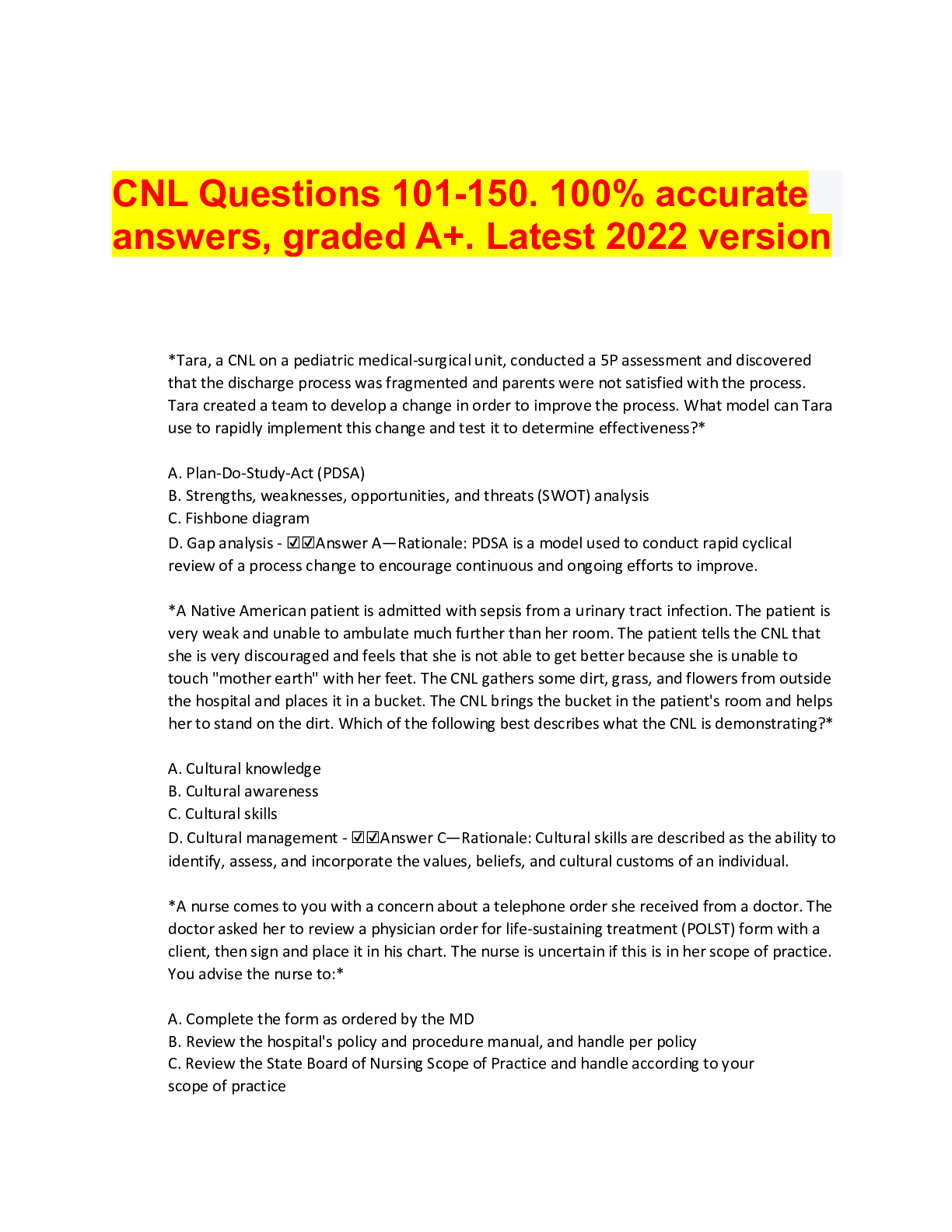
Also available in bundle (1)

ALL CNL EXAM DOCUMENTS; QUESTIONS AND ANSWERS. PREDICTOR QUESTIONS. DOWNLOAD TO SCORE A+
Composed of 8 documents. All CNL questions and answers, latest versions 2022. rated A+
By bundleHub Solution guider 1 year ago
$28
8
Reviews( 0 )
Document information
Connected school, study & course
About the document
Uploaded On
Aug 08, 2022
Number of pages
15
Written in
Additional information
This document has been written for:
Uploaded
Aug 08, 2022
Downloads
0
Views
97














